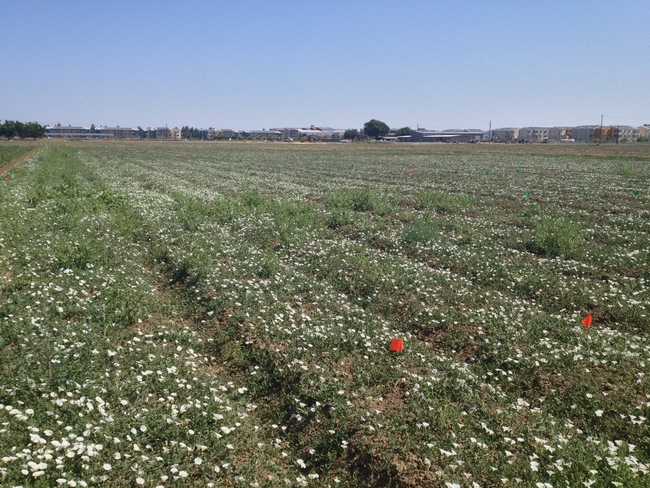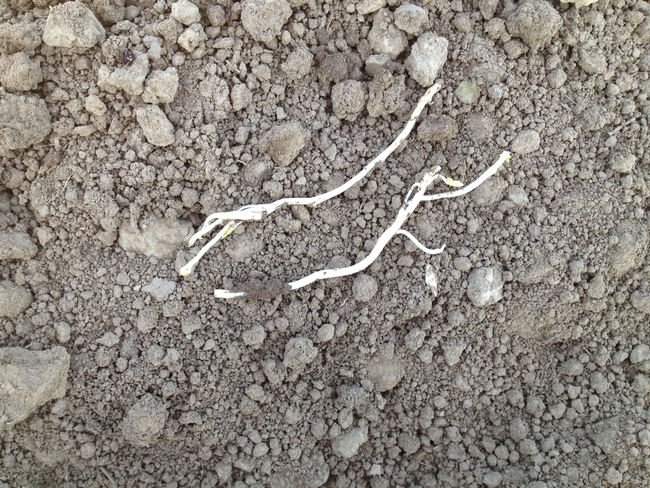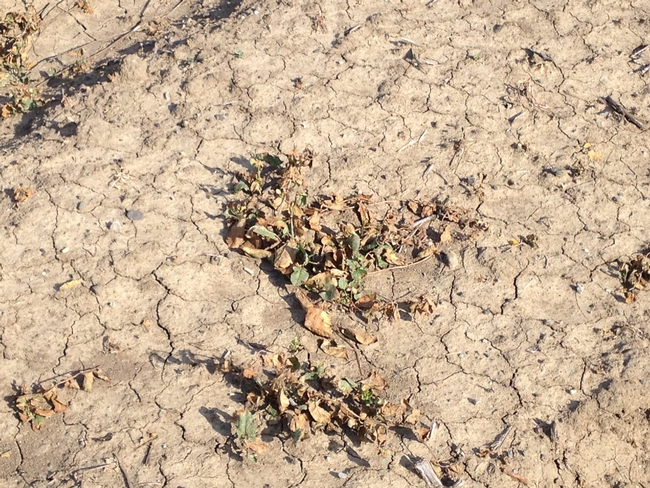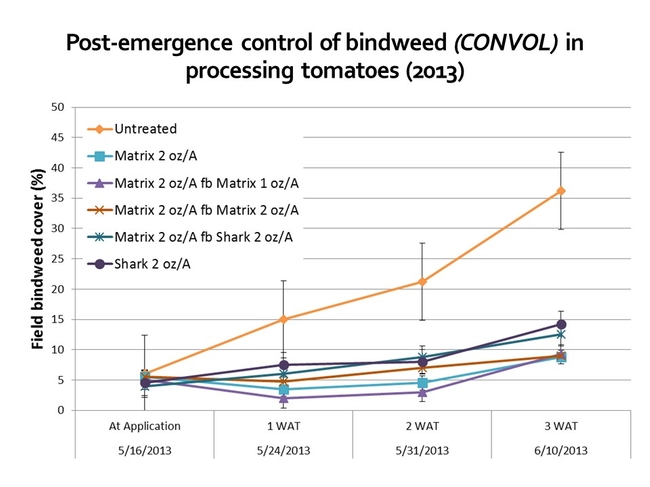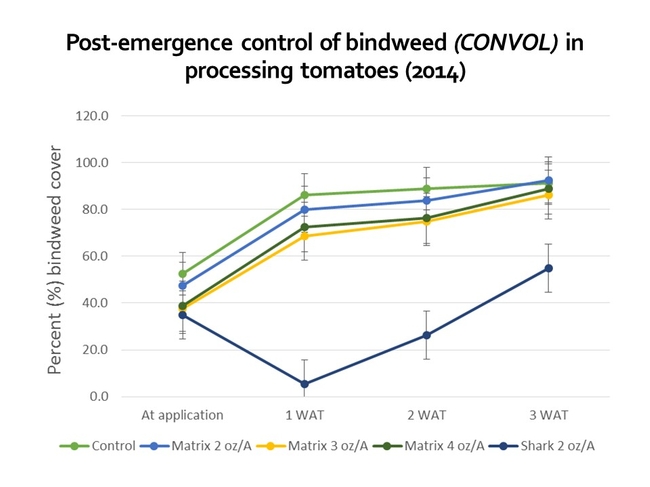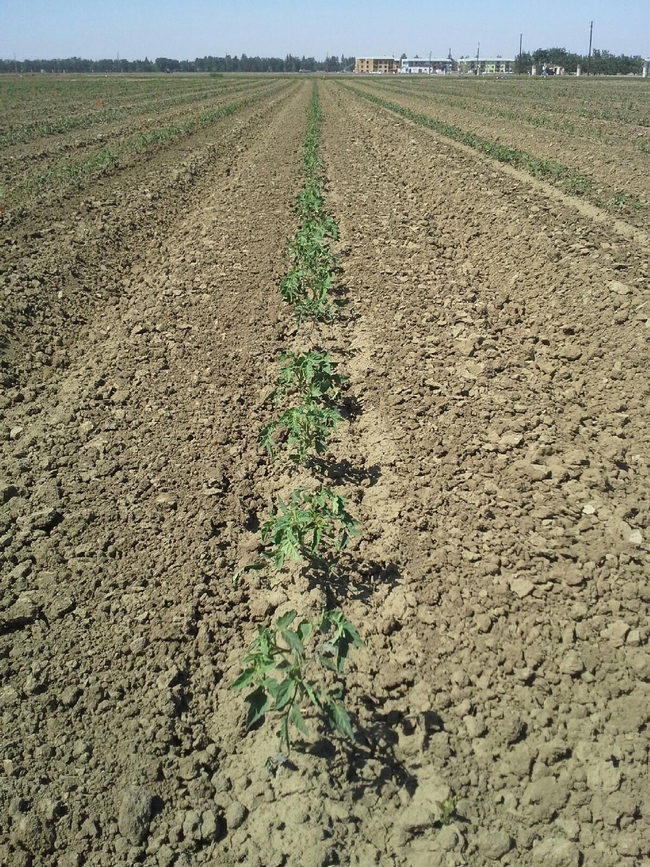You've got trouble with a capital "T" that rhymes with "B", which stands for bindweed.
My apologies to Meredith Wilson (I just couldn't pass up the opportunity...). But seriously, if you've got bindweed, you've probably got trouble. Field bindweed (Convolvulus arvensis) is a deep-rooted (and drought-tolerant) perennial vine that has become a significant concern in reduced-tillage, drip-irrigated, processing tomato systems.
Figure 1. Have you got trouble? Field bindweed at the UC Davis research farm.
Field bindweed, a native of Europe and Asia, is a member of the Convolvulaceae, or morning-glory, family. The species is characterized by creeping or climbing (when it has support) vines with spirally-arranged, arrow-like leaves and white to pink trumpet-shaped flowers. The root system of field bindweed can be quite extensive, reaching depths of up to 20 feet. Roots are brittle and infrequent mechanical disturbance may only serve to disseminate rhizome pieces around a field. Bindweed seeds are particularly long-lived; some reports indicate that they (the seeds) may even remain viable for 60 years. Although seedlings are easy to control with chemical and physical control measures, mature plants are significantly more resilient.
Figure 2. Rhizome pieces as short as two inches in length can become perennialized.
For the past two years, I've looked at bindweed responses to herbicides in order to maximize weed suppression in summer annual cropping systems. Specifically, I've evaluated pre-plant PP burndown, residual pre-plant incorporated (PPI) and pre-emergence (PRE), and post-emergence (POST) and shielded (SHIELD) herbicides for bindweed control in processing tomatoes.
Pre-plant burndown:
One of the main tenets of IPM is to start off clean! This means planting into fields with reduced weed densities and/or no emerged weed vegetation that can compete with a newly emerged/establishing crop. Results from 2013/2014 field trials show that an application of Roundup Powermax (1.75 qt/A) to actively growing vines (ten days prior to transplanting) can reduce field bindweed cover by more than 50% for up to eight weeks after transplanting (by which time the crop canopy should be starting to close in).
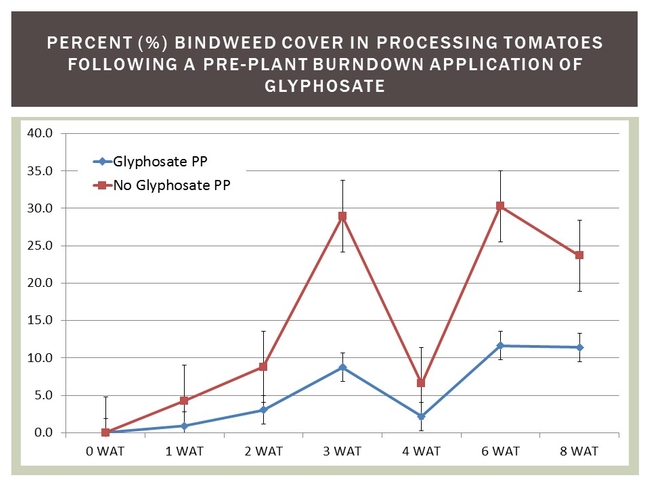
It is important to realized that field bindweed response to the active ingredient in Roundup can vary significantly in response to plant growth stage at the time of application, environmental factors and their influence on cuticle development, spray volume and natural variability among bindweed biotypes to glyphosate. Even under the best of application circumstances, a single application of Roundup (or any other herbicide, really) is unlikely to eradicate field bindweed.
Figure 4. Bindweed regrowth following an application of Roundup Powermax.
Pre-plant incorporated and pre-emergence herbicides:
The use of residual herbicides may help growers 'buy some time' against bindweed in severely infested fields. By this, I mean that growers can suppress vine emergence and growth while the tomato transplants become established. Research conducted by Tom Lanini (Professor Emeritus, UCD) and others has demonstrated that Treflan (trifluralin) is the most (consistently) effective product for managing bindweed in tomatoes. In my experience, Matrix (rimsulfuron) and Zeus (sulfentrazone) may also be effective, although rotation restrictions limit their use. Tank mixes with Dual Magnum may be advantageous if nutsedges are also a problem. One word of caution: crop injury can occur if transplant root balls are not positioned below the herbicide-treated zone! I've tended to see more injury with Zeus than with the other products, but. Regardless, make sure that you are applying the right product at the right rate with respect to your local environmental/soil conditions to maximize current and future crop safety!
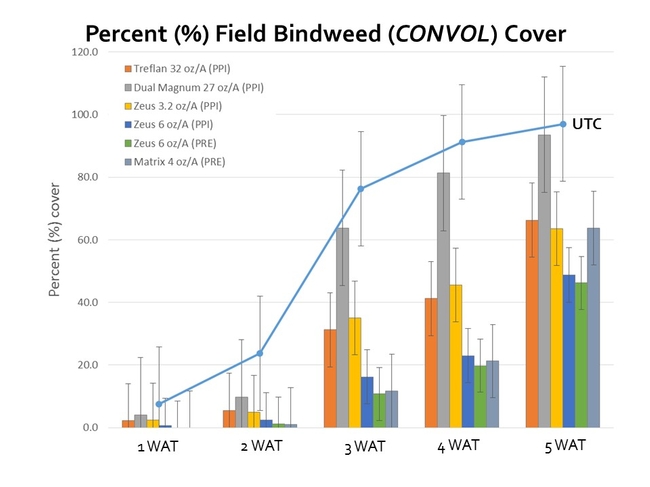
Post-emergence and shielded herbicides:
Recent research conducted in our lab has found that the application of Matrix POST or Shark (carfentrazone) SHIELD can reduce bindweed cover, relative to an untreated control, although extensive, vigorous vines are more likely to recover from herbicide applications. Matrix can 'yellow-up' tomatoes, although the injury is fairly transient. Shark must not come into contact with leaves, branches, and stems or serious crop injury can occur!
Figures 6 and 7. Results from research trials to look at Matrix and Shark efficacy for the control of field bindweed. Results suggest that POST and SHIELD applications may be more effective at managing the species when the starting weed cover is low (i.e. 5% in 2013 as compared to 40% in 2014). NOTE: The rates applied in this study were chosen for experimental reasons (several are NOT labeled for use on tomatoes); review all labels and select herbicide doses appropriate for your growing conditions.
Cultivation, crop rotation, and post-harvest weed control:
Chemicals aren't the only strategy for dealing with bindweed in tomatoes; frequent in-crop cultivation can also be suppressive. Rotating to corn or wheat, which would diversify the type and timing of weed control practices may also be beneficial. Another tool for managing field bindweed is engaging in weed control following crop harvest. I think that this could be very important, especially after wheat when the vines can grow unimpeded, although I have not, personally, evaluated summer vs. fall vs. spring herbicide applications to bindweed in crop stubble (that is on the 2015/2016 research agenda).
Figure 8. Cultivation following a PPI Treflan application.
More information about bindweed and bindweed management can be found at the UC Pest Notes page and the UC Crop Management page. Your farm adviser should also be able to provide you with more information about weed control, including field bindweed suppression, in tomatoes that is appropriate for your region. Herbicides and rates included in this study were chosen for experimental purposes; some are not legally registered for use in tomatoes in CA. Be sure to review all labels to ensure that you are applying appropriate products at appropriate rates!
